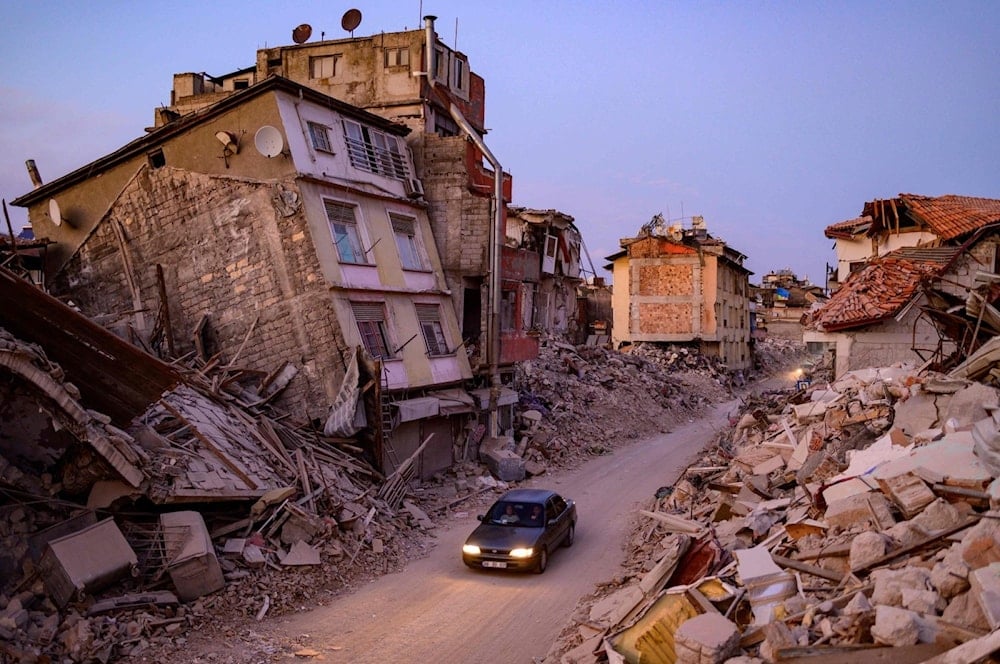Natural disasters caused more than $131 billion in losses so far
Munich Re reports $131 billion in global disaster losses in early 2025, driven by Los Angeles wildfires and severe US storms.
-

A car drives past collapsed buildings in Antakya, Hatay, southeastern Turkey, on February 20, 2023. (AFP)
Natural disasters around the world have caused more than $131 billion in losses during the first half of 2025, according to a new report released by insurance giant Munich Re. While the figure is slightly below the $155 billion recorded during the same period in 2024, it still sits well above historical averages.
The most devastating event so far this year was the series of wildfires in the Los Angeles area, which caused an estimated $53 billion in total damages, $40 billion of which were insured, making it the costliest natural disaster of 2025 to date.
Climate scientists say climate change played a key role in intensifying fire weather conditions that made the wildfires more destructive than in previous years.
Tobias Grimm, chief climate scientist at Munich Re, emphasized the growing role of climate change in driving the severity of such disasters. "We need to face it that the losses have been on the rise and make it clear that climate change plays an ever-increasing role," Grimm stated.
With more people living in high-risk areas and the continued escalation of extreme weather events, the damages and the insurance costs are expected to keep climbing.
Myanmar earthquake, US storms among other major events
Beyond the US, one of the most severe global disasters this year was the 7.7-magnitude earthquake that struck Myanmar in March, killing an estimated 4,500 people and causing $12 billion in damages. Very little of that loss was insured.
Severe thunderstorms in the United States also contributed significantly to the global damage toll. The four most expensive storm events occurred in March, April, and May, resulting in combined losses of about $19 billion, with $14.6 billion insured.
Out of the $131 billion in total global losses, $80 billion were insured, making this the second-highest figure for any first half of the year since Munich Re began tracking data in 1980. Only the first half of 2011, due to Japan’s catastrophic earthquake and tsunami, saw higher insured losses.
Seven of eight years surpass $100 billion in insured losses
Grimm noted that in seven of the last eight years, insured losses from natural disasters have exceeded $100 billion, a pattern that’s expected to continue, especially as the more active second half of the year begins with the Atlantic hurricane season in August.
Thomas Blunck, a member of the Board of Management at Munich Re, stressed the importance of adaptation and mitigation to reduce long-term risks.
"The best way to avoid losses is to implement effective preventive measures, such as more robust construction for buildings and infrastructure to better withstand natural disasters," Blunck said.
He added that new development should be discouraged in high-risk areas to keep insurance premiums reasonable and reduce exposure to future disasters.
8.8-magnitude earthquake strikes off Russia’s Kamchatka
On a related note, on Tuesday evening, a massive 8.8-magnitude undersea earthquake struck off the eastern coast of Russia’s Kamchatka Peninsula, prompting widespread tsunami warnings and evacuation orders across the Pacific region.
The quake, which occurred at approximately 8:25 am local time (23:25 GMT), was centered about 136 kilometers east of Petropavlovsk-Kamchatsky, according to seismological data. It is one of the strongest earthquakes recorded in the region in recent decades.
"The strongest earthquake since 1952 has just occurred in the Kamchatka seismic zone... Given the scale of the event, strong aftershocks with a magnitude of up to 7.5 should be expected," Kamchatka's geophysical service said on Telegram.
Following the earthquake, Russian authorities issued tsunami warnings along Kamchatka’s eastern coastline. Tsunami waves reaching up to four meters were observed in some coastal areas. Residents were urged to evacuate low-lying zones, and emergency sirens sounded across multiple towns and villages.

 4 Min Read
4 Min Read










